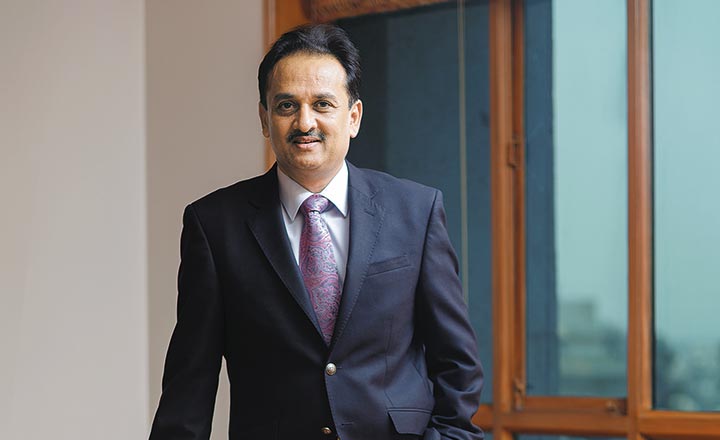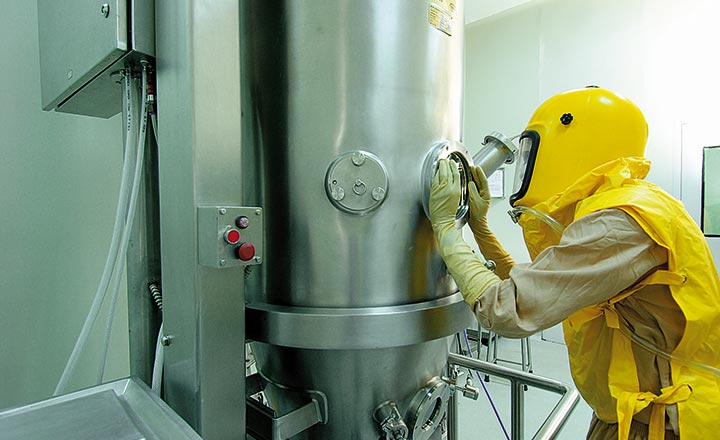After coming into being in 1985, Intas Pharma had a slow start for about a decade. Its strategy was always to gain a foothold in the chronic therapeutic business, which included neurology and psychiatry. The big break came with the foray into oncology, which has given the company a serious foothold in the international markets. Intas’ strength lies in its ability to identify segments before competition. It managed to do so in oncology and later on with infertility. Now, with the acquisition of Actavis’ assets in the UK and Ireland, its position in the European market will only get stronger. It is hoping to replicate the success story with its entry into biosimilars after having been the first company to launch its offerings in the EU. Even in the domestic market, Intas is among the top ten. Its sustained growth story has helped it in attracting private equity funding and making it the most valuable unlisted Indian
pharma company
On a routine work visit to Europe in 2007, Binish Chudgar stopped over at Barnstaple, the main town of North Devon district in the UK. The natural beauty of the location immediately struck him. As he prepared for a meeting with the folks at Actavis Generics, he wondered why anyone would have a manufacturing plant here. Chudgar’s Intas Pharmaceuticals, an Ahmedabad-based company that had slowly made a name for itself in India, was there to discuss a potential contract manufacturing deal. The meeting went off reasonably well, though Chudgar sensed some degree of reluctance on Actavis’ part to source work to India. “We never got the deal but at least got to see a great tourist spot,” chuckles Chudgar.
Almost a decade later, Intas swooped the assets of Actavis in the UK and Ireland last October for an eye-popping £603 million (Rs.5,117 crore). It was not much less than Intas’ FY16 turnover of Rs.6,570 crore that came with a net profit of Rs.883 crore. Industry trackers were stunned as Intas got past the likes of Aurobindo Pharma to clinch the deal. The sale of this asset was necessitated after the Israeli pharma company Teva acquired Actavis for $40.5 billion in mid-2015 and the subsequent anti-trust divestiture requirements from the European Commission. “I never expected to buy the company when I visited the plant years ago,” says Chudgar, Intas’ vice-chairman and managing director.
The deal now places Intas right on top of the UK and Ireland markets from being eighth. For the low profile Intas, which has never sat down for a detailed media interaction barring this one, being in the limelight has been a new experience. In the conference room of his 200,000 sq. ft. office building in Ahmedabad’s Thaltej area, Chudgar speaks about his company’s growth story of rising from just Rs.20 crore in 1999 to Rs.7,500 crore in 2017. “I think we have done a few things right,” he says modestly. From having many offices in the city, there are 800 people who all sit together in this large building, which is just a couple of months old. “This is a one-stop-shop office with suites and private offices,” says the 53-year-old Chudgar.
The tightly-knit Intas was started in 1985 by Hasmukh Chudgar, who is still the chairman, and by Binish and his two older brothers, Nimish and Urmish. The company has made a mark for itself in chronic therapy areas like oncology, CNS (central nervous system), cardiovascular and diabetology. The company gets 65% of its revenue from exports and the rest from the domestic market.
Emphasising on the strong research focus, Chudgar opens up about what lies ahead. If identifying growth opportunities in cancer therapy early in the day worked really well, he is confident that he can recreate that story in a different way all over again – and with that kind of success, to boot.

Getting it together
Tapping his fingers gently on the table, Chudgar talks about the deal that has kept him in the news, and also about the Intas journey. “We may be the seventh or eighth largest pharma company in India but we are definitely the fastest growing,” he says. Given how ultra competitive India is, he decided that he needed to be the biggest in the UK, which has been the base for his overseas foray.
Chudgar spends a moment dwelling on why that makes such a difference. “When a generic molecule is launched there, the top three companies corner an 85% share. The other 20 companies struggle to get a part of the other 15%, which is not a good situation to be in,” he explains. Without that big buyout, it would have been impossible to break into the top three. “The scale of operations makes a huge difference and that’s why we had to buy Actavis,” he says. Along with the 800 people who work at Barnstaple, its workforce outside India stands at 2,500. India has 6,000 on the field and a workforce of another 7,000 across its eight plants.
With the completion of the Actavis deal, the stage is now set to consolidate the overseas story. Interestingly, the initial bid that Intas put out was £1 billion. After taking a closer look at the assets and some accompanying litigation cases, it was scaled down to £650 million. “The process started off in July last year and it was clear that Teva wanted to move fast. They had a larger merger to deal with,” points out Chudgar. He says there would have been no regrets had Intas lost the bid. “I think it’s a fair price.”
To drive home his point, Chudgar points out that this asset had a profit of £125 million on revenue of £250 million. “In fact, we could have paid another £100 million if there was a need. This was Actavis’ best performing asset when it came to margins,” he emphasises. According to an ICRA report, the £603 million Actavis deal was valued at 2.5x sales and close to 5x Ebitda.
Even with a potential hit in profit to £75 million, Chudgar believes the payback on this investment will be done in four to five years. It is apparent that Intas will see most of its revenue coming from the overseas markets. “We would like to de-risk our Indian business. If any of my plants come under Form 483 (a form issued to a company at the end of an inspection that mentions that there has been a violation of the US Food, Drugs and Cosmetic Act), that would make me very vulnerable,” he says plainly.

Growth and more growth
Sanjiv Kaul first met Chudgar and his brother, Nimish during his stint in Ranbaxy in the late 1990s. This was when Kaul was running Ranbaxy’s India business and they were looking at Intas as an option for product collaboration. To this day, he remembers being impressed with the duo and says they complemented each other. “Binish is the visionary and the strategist, who can think ahead of the curve. He is very market savvy and fully aware of what is going on in the global marketplace. Nimish is the go-to guy, one who has great technical skills and the ability to set up world class infrastructure,” he says. The third brother, Urmish focuses on the biotechnology development, whom Kaul refers to as “Mr Science.”
About five years later in 2004, Kaul moved out of Ranbaxy to ChrysCapital. Very shortly, the PE (private equity) fund put in $11 million (then Rs.50 crore) for a 12.5% stake in Intas Pharma, its first pharma investment in India. This was not just an investment but a chance for Intas to work very closely with Kaul, acknowledged to be the man who took Ranbaxy to international markets. “At that point, Intas was a Rs.450 crore company of which just Rs.100 crore came from exports,” says Kaul, partner at ChrysCapital. Of the domestic business of Rs.350 crore, the share of chronic therapies was just Rs.150 crore.
According to him, the first few years starting from 2004 were spent in building competencies in chronic therapies in the domestic market such as anti-hypertensives, anti-diabetics and CNS agents. “The strategy was to avoid the mass market and focus clearly on hard-to-replicate and hard-to-penetrate sub-segments, where competition would be selective and doctor patronage would be for extended periods. This is where chronic therapy was a huge opportunity,” he says. Similarly, Kaul cites the instance of Intas focusing on niche products like injectables and oncology rather than oral solids or vanilla generics in developed markets like the USA, Canada, the UK and Europe.
It was clear to the Chudgar brothers that exports had to grow substantially from where it was. Even of the Rs.100 crore figure, as much as Rs.85 crore was from the UK. “Intas’ strategy was to get into chronic in India, which would cover areas like CNS, cardiovascular and diabetes, while the export market would grow with injectables for oncology. Binish quickly realised the need for Intas to develop the requisite competencies not only in India but also in developed markets like USA and Europe/UK,” Kaul recalls.
According to him, the brothers made sizeable investments in manufacturing and marketing infrastructure to build a vast basket of niche products. “This would establish and consolidate its market share in developed markets,” says Kaul, who gives a lot of credit to Binish’s foresight and confidence in his ability to focus on these segments and backing it up with the required investments. “At the back-end, Nimish brought in the depth and wherewithal on the manufacturing and technical side to cater to global requirements apart from managing the profitable domestic business,” he explains. Intas first moved to the UK and then the US. The logic was that the UK is a relatively easier market to penetrate. But soon, it realised that maximum value creation would take place in the US.
For ChrysCapital, the Intas story has been a big one. The fund infusion in 2004 (bought from ICICI Ventures that invested in Intas in 1996) was followed up by an acquisition of another 4% in 2012 for Rs.300 crore, taking the total holding to a little over 16%. Intas’ valuation of Rs.425 crore in 2004 moved up to Rs.4,800 crore in 2012. In November 2014, when ChrysCapital sold 10.13% to Temasek Holdings for Rs.880 crore, it stood at $1.5 billion (Rs.9,000 crore). That deal alone gave ChrysCapital a 10x return on its original investment. “We were early investors in the Indian generics space in companies such as Dr Reddys and Medreich over a decade ago. Indian pharma companies have a strong competitive advantage in terms of strong domain expertise in chemistry, manufacturing excellence and robust understanding of regulatory and quality framework,” says R Venkatesh, managing director, Temasek Holdings Advisors (India) justifying the Intas investment.
In April this year, when Capital International picked up a 3% stake from ChrysCapital for Rs.690 crore, the valuation zoomed to $3.5 billion (Rs.23,000 crore). “We have invested in Intas from across our three funds (III, V and VII), which itself is a record of sorts in the PE industry globally,” says Kaul.
The focus on chronic has been one of the key reasons for Intas’ impressive growth and has given it a key strategic advantage, especially in oncology. According to Dr Satyanarayana Chava, founder and CEO of Hyderabad-based Laurus Labs, oncology attracts few players and not without reason. “The gestation period for an oncology drug is five to six years, which makes it a significant entry barrier. There is a lot of research involved and that poses a challenge to most people wanting to be in the business,” he says. Laurus, a Rs.1,775 crore company with investors such as private equity giant Warburg Pincus, manufactures active pharmaceutical ingredients (APIs) for oncology, Hepatitis C and anti-retroviral. Chava admits that the volume in APIs for oncology is still quite small. “A player with a vertical integration presence that covers APIs and formulation is the real winner here.” There is another sound reason to be in oncology. Chava points out that drug prices have not dropped. “For someone who is already there with scale, it can be an extremely attractive proposition,” he says.
In good pharm
In several ways, the Actavis buyout has been a clear departure from Intas’ inorganic strategy. Historically, the average ticket size for its buyouts was always less than $10 million. According to Prashant Jain, director (life sciences), o3 Capital, the firm that advised Intas on the buyout of a cardiac product from Canada’s Orbus Pharma in 2010, the strategy was to always to get a market or product segment, which would help in filling a gap. “With Actavis, Intas has gone past its approach of tuck-in acquisitions (made with the objective of merging into an existing division) and instead gone after an asset that gives it a commanding position in the regulated markets of Western Europe where Intas has already built a strong position organically,” he explains.
This can be compared to the period between 2007 and 2012 when Indian pharma companies such as Ranbaxy, Dr Reddy’s and Wockhardt made large buyouts in Europe. The going got tough with regulatory pressure to bring down healthcare costs. Emphasising that Intas was clever to stay out of this game, Jain says the approach was to strengthen its home base and focus on regulated export markets instead of making an outright acquisition there. “Back home, Intas focused on growing its cardiac and CNS strategy and at the same time commenced working on biosimilars very early (through Intas Biopharma, which was subsequently merged into Intas), a category that Indian companies seem to have missed to Chinese companies. Backed by strong in-house research, Intas is a key player in neurology and cardiac therapeutic segments,” he adds.
Though Chudgar displays a high level of conviction on biosimilars (medicines made from living microorganisms found in plant or animal cells), there is a certain level of cautious optimism. “It is an extremely tough market to be in and yet, still worth it. If done well, it can offer gross margins as high as 60%,” he says.
Intas is banking on how well it has done in the past to get it right again. Spotting opportunity in new segments has undoubtedly been its strength. Jain speaks of the work that it started on infertility drugs as far back as 2005-07 and points out that research took six to seven years before the drug was launched in 2013-14. “It is today an over Rs.60 crore brand. Competition has only now launched their products, realising the market potential,” he explains.
For Intas, the journey is still underway and Chudgar already speaks of the possibility of more Teva assets in other parts of the world coming up for bidding. “Obviously, we will be interested,” he says without giving anything more away. He is clearly upbeat about what the future has in store for Intas. “Our best is yet to come. We have still not opened our best cards,” says Chudgar breaking into a billion dollar smile.









 Just one email a week
Just one email a week